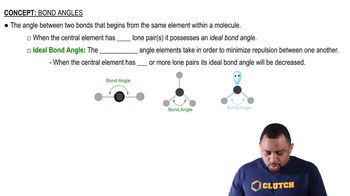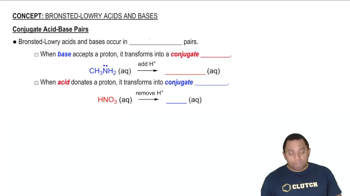Ch.23 - Organic and Biological Chemistry
Chapter 23, Problem 129
Show by drawing structures how the sugar and nitrogenous base components of a nucleic acid are joined.
 Verified step by step guidance
Verified step by step guidance1
Step 1: Identify the components of a nucleic acid. A nucleic acid is composed of a sugar, a nitrogenous base, and a phosphate group. For this problem, we will focus on the sugar and nitrogenous base components.
Step 2: Recognize the sugar component. In nucleic acids, the sugar is either ribose (in RNA) or deoxyribose (in DNA). Both sugars are pentoses, meaning they have five carbon atoms.
Step 3: Identify the nitrogenous base. There are two types of nitrogenous bases: purines (adenine and guanine) and pyrimidines (cytosine, thymine, and uracil). These bases attach to the sugar molecule.
Step 4: Understand the glycosidic bond formation. The nitrogenous base is attached to the sugar via a glycosidic bond. This bond forms between the 1' carbon of the sugar and a nitrogen atom in the base (N-9 in purines and N-1 in pyrimidines).
Step 5: Draw the structure. Start by drawing the sugar ring, then attach the nitrogenous base to the 1' carbon of the sugar using a line to represent the glycosidic bond. Ensure the correct orientation of the base relative to the sugar.
Key Concepts
Here are the essential concepts you must grasp in order to answer the question correctly.
Nucleotides
Nucleotides are the building blocks of nucleic acids, consisting of three components: a nitrogenous base, a five-carbon sugar (ribose in RNA and deoxyribose in DNA), and a phosphate group. The sugar and nitrogenous base are covalently bonded to form a nucleotide, which is essential for the structure and function of DNA and RNA.
Phosphodiester Bond
A phosphodiester bond is a type of covalent bond that links the 5' phosphate group of one nucleotide to the 3' hydroxyl group of another nucleotide's sugar. This bond forms the backbone of nucleic acid strands, allowing for the formation of long chains of nucleotides that encode genetic information.
Recommended video:
Guided course

Bond Angles
Base Pairing
Base pairing refers to the specific hydrogen bonding between nitrogenous bases in nucleic acids, where adenine pairs with thymine (or uracil in RNA) and cytosine pairs with guanine. This complementary pairing is crucial for the stability of the DNA double helix and for accurate replication and transcription processes.
Recommended video:
Guided course

Conjugate Acid-Base Pairs
Related Practice
